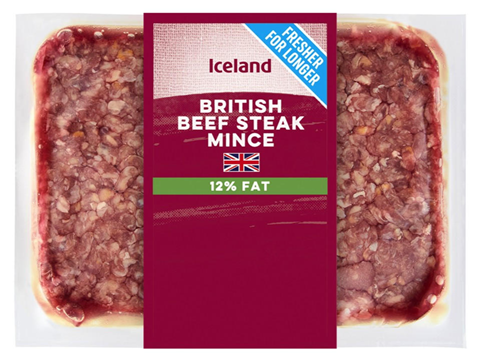
By transitioning into new vacuum packaging across its beef and pork mince range, Iceland Foods plans to increase the products’ shelf life by almost 50% and reduce its own annual plastic consumption by 35 tonnes.
A twelve-week trial was conducted across fifty Iceland stores across the UK earlier this year. Now the new airtight packaging design will replace the existing plastic tray, as it is said to consist of 50% less plastic and reduce the volume of plastics in the retailer’s supply chain.
The vacuum pack is anticipated to keep the products fresh for approximately two and a half weeks. It is also expected to be more size efficient, meaning more packs can fit into one delivery truck – a development set to lower the retailer’s carbon footprint and improve availability for consumers.
Iceland claims it is the first supermarket to simultaneously implement such packaging into its beef and pork mince lines. The packaging will be available in over 1,000 stores across the UK and online this month.
Zach Nowell, category buying manager for Fresh Meat and Poultry at Iceland Food, commented: “We’re always striving to provide our customers with the best products we possibly can, and making sure that we’re listening to what is important to them.
“Our new vacuum-packaged beef mince means our customers are getting the same quality-assured beef mince they love, but with an even longer shelf life. We’re thrilled to also be leading the way as the first UK supermarket to roll out this packaging for pork mince.
“Now more than ever it’s important for families to get the best value for money when doing their weekly shopping, and our new packaging offers a wider selection of longer-lasting quality products.”
Stuart Lendrum, director of Product, Process and Sustainability at Iceland Foods, added: “As we continue to minimize Iceland’s impact on the environment with new innovations, this sustainable switch will see a 50 percent reduction in plastic for our beef and pork mince products, as well as a reduced number of trucks on the road needed to transport it.”
Iceland is the latest in a line of retailers to transition into vacuum packaging for their meat products. Last summer, Lidl aimed to reduce its plastic consumption by 63% and save 250 tonnes annually with its vacuum-packed beef mince; while a similar solution from Asda, unveiled in February 2024, claimed to contain 60% less plastic in an effort to cut 60 tonnes out of its operations every year.
Not every transition has been so successful, however. Sainsbury’s originally sought to cut 55% of plastic per product and save a yearly 450 tonnes of plastic by vacuum packing its beef mince range. Consumers complained that the change had impacted the product’s texture and appearance; and that, whereas the old packaging had been recyclable at kerbside, the new design needed to be returned to the store for recycling and was therefore less convenient.
Robert Lilienfeld, founder and executive director of sustainable packaging think tank SPRING, described the Sainsbury’s solution as a ‘complete failure’ – asserting that the unappealing physical impacts would decrease sales and increase food waste; that the green colours used on the packaging were inherently unappealing on supermarket shelves; and more.
If you liked this story, you might also enjoy:
How are the top brands progressing on packaging sustainability?
Sustainable Innovation Report 2024: Current trends and future priorities
Reuse vs. single use – which is better for the environment?
The ultimate guide to global plastic sustainability regulation












No comments yet